Fatal embraces, deadlocks, and obscure bugs await the programmer who isn't careful about priority inversions.
A preemptive real-time operating system
(RTOS) forms the backbone of most embedded systems devices, from
digital cameras to life-saving medical equipment. The RTOS can schedule
an application's activities so that they appear to occur
simultaneously. By rapidly switching from one activity to the next, the
RTOS is able to quickly respond to real-world events.
To ensure rapid response times, an
embedded RTOS can use preemption, in which a higher-priority task can
interrupt a low-priority task that's running. When the high-priority
task finishes running, the low-priority task resumes executing from the
point at which it was interrupted. The use of preemption guarantees
worst-case performance times, which enable use of the application in
safety-critical situations.
Unfortunately, the need to share
resources between tasks operating in a preemptive multitasking
environment can create conflicts. Two of the most common problems are
deadlock and priority inversion, both of which can result in
application failure. In 1997, the Mars Pathfinder mission nearly failed
because of an undetected priority inversion. When the rover was
collecting meteorological data on Mars, it began experiencing system
resets, losing data. The problem was traced to priority inversion. A
solution to the inversion was developed and uploaded to the rover, and
the mission completed successfully. Such a situation might have been
avoided had the designers of the rover accounted for the possibility of
priority inversion.1
This article describes in detail the
problem of priority inversion and indicates two common solutions. Also
provided are detailed strategies for avoiding priority inversion.
Avoiding priority inversion is preferable to most other solutions,
which generally require more code, more memory, and more overhead when
accessing shared resources.
Priority inversion
Priority
inversion occurs when a high-priority task is forced to wait for the
release of a shared resource owned by a lower-priority task. The two
types of priority inversion, bounded and unbounded, occur when two
tasks attempt to access a single shared resource. A shared resource can
be anything that must be used by two or more tasks in a mutually
exclusive fashion. The period of time that a task has a lock on a
shared resource is called the task's critical section or critical
region.

Figure 1: Bounded priority inversion
Bounded priority inversion, shown
in Figure 1, occurs when low-priority Task L acquires a lock on a
shared resource, but before releasing the resource is preempted by
high-priority Task H.2 Task H
attempts to acquire the resource but is forced to wait for Task L to
finish its critical section. Task L continues running until it releases
the resource, at which point Task H acquires the resource and resumes
executing. The worst-case wait time for Task H is equal to the length
of the critical section of Task L. Bounded priority inversion won't
generally hurt an application provided the critical section of Task L
executes in a timely manner.

Figure 2: Unbounded priority inversion
Unbounded priority inversion, shown in Figure 2, occurs when an intervening task extends a bounded priority inversion, possibly forever.2
In the previous example, suppose medium-priority Task M preempts Task L
during the execution of Task L's critical section. Task M runs until it
relinquishes control of the processor. Only when Task M turns over
control can Task L finish executing its critical section and release
the shared resource. This extension of the critical region leads to
unbounded priority inversion. When Task L releases the resource, Task H
can finally acquire the resource and resume execution. The worst-case
wait time for Task H is now equal to the sum of the worst-case
execution times of Task M and the critical section of Task L. Unbounded
priority inversion can have much more severe consequences than a
bounded priority inversion. If Task M runs indefinitely, neither Task L
nor Task H will get an opportunity to resume execution.
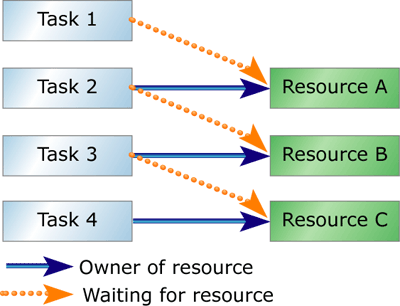
Figure 3: Chain of nested resource locks
Priority inversion can have an even more severe effect on an application when there are nested resource locks,
as shown in Figure 3. Suppose Task 1 is waiting for Resource A.
Resource A is owned by lower-priority Task 2, which is waiting for
Resource B. Resource B is owned by still lower-priority Task 3, which
is waiting for Resource C, which is being used by an even lower
priority Task 4. Task 1 is blocked, forced to wait for tasks 4, 3, and
2 to finish their critical regions before it can begin execution. Such
a chain of nested locks is difficult to resolve quickly and
efficiently. The risk of an unbounded priority inversion is also high
if many tasks intervene between tasks 1 and 4.
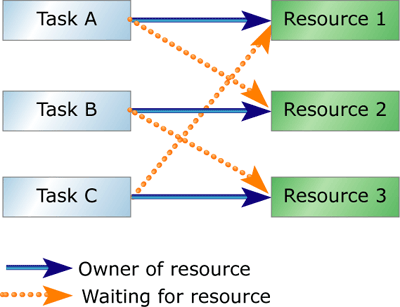
Figure 4: Deadlock
Deadlock
Deadlock, shown in Figure 4, is a special case of nested
resource locks, in which a circular chain of tasks waiting for
resources prevents all the tasks in the chain from executing.2
Deadlocked tasks can have potentially fatal consequences for the
application. Suppose Task A is waiting for a resource held by Task B,
while Task B is waiting for a resource held by Task C, which is waiting
for a resource held by Task A. None of the three tasks is able to
acquire the resource it needs to resume execution, so the application
is deadlocked.
Priority ceiling protocol
One way to solve priority inversion is to use the priority ceiling protocol,
which gives each shared resource a predefined priority ceiling. When a
task acquires a shared resource, the task is hoisted (has its priority
temporarily raised) to the priority ceiling of that resource. The
priority ceiling must be higher than the highest priority of all tasks
that can access the resource, thereby ensuring that a task owning a
shared resource won't be preempted by any other task attempting to
access the same resource. When the hoisted task releases the resource,
the task is returned to its original priority level. Any operating
system that allows task priorities to change dynamically can be used to
implement the priority ceiling protocol.3
A static analysis of the application is
required to determine the priority ceiling for each shared resource, a
process that is often difficult and time consuming. To perform a static
analysis, every task that accesses each shared resource must be known
in advance. This might be difficult, or even impossible, to determine
for a complex application.
The priority ceiling protocol provides a
good worst-case wait time for a high-priority task waiting for a shared
resource. The worst-case wait time is limited to the longest critical
section of any lower-priority task that accesses the shared resource.
The priority ceiling protocol prevents deadlock by stopping chains of
nested locks from developing.
On the downside, the priority ceiling
protocol has poor average-case response time because of the significant
overhead associated with implementing the protocol. Every time a shared
resource is acquired, the acquiring task must be hoisted to the
resource's priority ceiling. Conversely, every time a shared resource
is released, the hoisted task's priority must be lowered to its
original level. All this extra code takes time.
By hoisting the acquiring task to the
priority ceiling of the resource, the priority ceiling protocol
prevents locks from being contended. Because the hoisted task has a
priority higher than that of any other task that can request the
resource, no task can contend the lock. A disadvantage of the priority
ceiling protocol is that the priority of a task changes every time it
acquires or releases a shared resource. These priority changes occur
even if no other task would compete for the resource at that time.
Medium-priority tasks are often
unnecessarily prevented from running by the priority ceiling protocol.
Suppose a low-priority task acquires a resource that's shared with a
high-priority task. The low-priority task is hoisted to the resource's
priority ceiling, above that of the high-priority task. Any tasks with
a priority below the resource's priority ceiling that are ready to
execute will be prevented from doing so, even if they don't use the
shared resource.
Priority inheritance protocol
An alternative to the priority ceiling protocol is the priority inheritance protocol,
a variation that uses dynamic priority adjustments. When a low-priority
task acquires a shared resource, the task continues running at its
original priority level. If a high-priority task requests ownership of
the shared resource, the low-priority task is hoisted above the
requesting task. The low-priority task can then continue executing its
critical section until it releases the resource. Once the resource is
released, the task is dropped back to its original low-priority level,
permitting the high-priority task to use the resource it has just
acquired.3
Because the majority of locks in
real-time applications aren't contended, the priority inheritance
protocol has good average-case performance. When a lock isn't
contended, priorities don't change; there is no additional overhead.
However, the worst-case performance for the priority inheritance
protocol is worse than the worst-case priority ceiling protocol, since
nested resource locks increase the wait time. The maximum duration of
the priority inversion is the sum of the execution times of all of the
nested resource locks. Furthermore, nested resource locks can lead to
deadlock when you use the priority inheritance protocol. That makes it
important to design the application so that deadlock can't occur.
Nested resource locks should obviously be
avoided if possible. An inadequate or incomplete understanding of the
interactions between tasks can lead to nested resource locks. A
well-thought-out design is the best tool a programmer can use to
prevent these.
You can avoid deadlock by allowing each
task to own only one shared resource at a time. When this condition is
met, the worst-case wait time matches the priority ceiling protocol's
worst-case wait. In order to prevent misuse, some operating systems
that implement priority inheritance don't allow nested locks. It might
not be possible, however, to eliminate nested resource locks in some
applications without seriously complicating the application.
But remember that allowing tasks to
acquire multiple priority inheritance resources can lead to deadlock
and increase the worst-case wait time.
Priority inheritance is difficult to
implement, with many complicated scenarios arising when two or more
tasks attempt to access the same resources. The algorithm for resolving
a long chain of nested resource locks is complex. It's possible to
incur a lot of overhead as hoisting one task results in hoisting
another task, and another, until finally some task is hoisted that has
the resources needed to run. After executing its critical section, each
hoisted task must then return to its original priority.
Figure 5 shows the simplest case of the
priority inheritance protocol in which a low-priority task acquires a
resource that's then requested by a higher priority task. Figure 6
shows a slightly more complex case, with a low-priority task owning a
resource that's requested by two higher-priority tasks. Figure 7
demonstrates the potential for complexity when three tasks compete for
two resources.
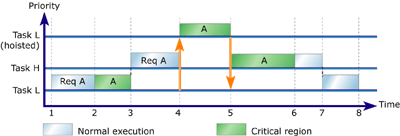
Figure 5: Simple priority inheritance
- Task L receives control of the processor and begins executing.
- The task makes a request for Resource A.
- Task L is granted ownership of Resource A and enters its critical region.
- Task L is preempted by Task H, a higher-priority task.
- Task H begins executing and requests ownership of Resource A, which is owned by Task L.
- Task L is hoisted to a priority above Task H and resumes executing its critical region.
- Task L releases Resource A and is lowered back to its original priority.
- Task H acquires ownership of Resource A and begins executing its critical region.
- Task H releases Resource A and continues executing normally.
- Task H finishes executing and Task L continues executing normally.
- Task L finishes executing.

Figure 6: Three-task, one-resource priority inheritance
- Task 3 gets control of the processor and begins executing.
- The task requests ownership of Resource A.
- Task 3 acquires Resource A and begins executing its critical region.
- Task 3 is preempted by Task 2, a higher-priority task.
- Task 2 begins executing normally and requests Resource A, which is owned by Task 3.
- Task 3 is hoisted to a priority above Task 2 and resumes executing its critical region.
- Task 3 is preempted by Task 1, a higher-priority task.
- Task 1 begins executing and requests Resource A, which is owned by Task 3.
- Task 3 is hoisted to a priority above Task 1.
- Task 3 resumes executing its critical region.
- Task 3 releases Resource A and is lowered back to its original priority.
- Task 1 acquires ownership of Resource A and begins executing its critical region.
- Task 1 releases Resource A and continues executing normally.
- Task 1 finishes executing. Task 2 acquires Resource A and begins executing its critical region.
- Task 2 releases Resource A and continues executing normally.
- Task 2 finishes executing. Task 3 resumes and continues executing normally.
- Task 3 finishes executing.
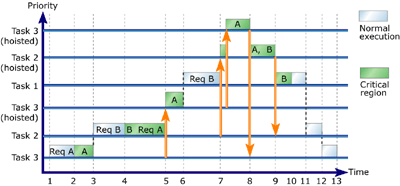
Figure 7: Three-task, two-resource priority inheritance
- Task 3 is given control of the processor and begins executing. The task requests Resource A.
- Task 3 acquires ownership of Resource A and begins executing its critical region.
- Task 3 is preempted by Task 2, a higher-priority task. Task 2 requests ownership of Resource B.
- Task 2 is granted ownership of Resource B and begins executing its critical region.
- The task requests ownership of Resource A, which is owned by Task 3.
- Task 3 is hoisted to a priority above Task 2 and resumes executing its critical region.
- Task 3 is preempted by Task 1, a higher-priority task.
- Task 1 requests Resource B, which is owned by Task 2.
- Task 2 is hoisted to a priority above Task 1.
However, Task 2 still can't execute because it must wait for Resource
A, which is owned by Task 3.
- Task 3 is hoisted to a priority above Task 2 and continues executing its critical region.
- Task 3 releases Resource A and is lowered back to its original priority.
- Task 2 acquires ownership of Resource A and resumes executing its critical region.
- Task 2 releases Resource A and then releases Resource B. The task is lowered back to its original priority.
- Task 1 acquires ownership of Resource B and begins executing its critical region.
- Task 1 releases Resource B and continues executing normally.
- Task 1 finishes executing. Task 2 resumes and continues executing normally.
- Task 2 finishes executing. Task 3 resumes and continues executing normally.
- Task 3 finishes executing.
Manage resource ownership
Most RTOSes that support priority inheritance require resource locks to
be properly nested, meaning the resources must be released in the
reverse order to that in which they were acquired. For example, a task
that acquired Resource A and then Resource B would be required to
release Resource B before releasing Resource A.
Figure 7 provides an example of priority
inheritance in which two resources are released in the opposite order
to that in which they were acquired. Task 2 acquired Resource A before
Resource B; Resource B was then released before Resource A. In this
example, Task 2 was able to release the resources in the proper order
without adversely affecting the application.
Many operating systems require resources
to be released in the proper order because it's difficult to implement
the capability to do otherwise. However, situations occur in which
releasing the resources in the proper order is neither possible nor
desirable. Suppose there are two shared resources: Resource B can't be
acquired without first owning Resource A. At some point during the
execution of the critical region with Resource B, Resource A is no
longer needed. Ideally, Resource A would now be released.
Unfortunately, many operating systems don't allow that. They require
Resource A to be held until Resource B is released, at which point
Resource A can be released. If a higher-priority task is waiting for
Resource A, the task is kept waiting unnecessarily while the resource's
current owner executes.

Figure 8: Managing resource ownership (example 1)
- Task L is given control of the processor and begins executing. Task L requests Resource A.
- Task L acquires ownership of Resource A and begins executing its critical region.
- Task L requests Resource B.
- Task L acquires ownership of Resource B and continues executing its critical region.
- Task L is preempted by Task H, a higher-priority task.
- Task H requests ownership of Resource A, which is owned by Task L.
- Task L is hoisted above Task H and continues executing its critical region.
- Task L releases Resource A even though it was acquired before Resource B.
- Task L is lowered to its original priority level.
- Task H acquires Resource A and begins executing its critical region.
- Note that low-priority Task L no longer prevents Task H from running, even though Task L still owns Resource B.
- Task H releases Resource A and continues executing normally.
- Task H finishes executing and Task L continues executing its critical region.
- Task L releases Resource B and continues executing normally.
- Task L finishes executing.
In Figure 8, Task L releases its
resources in the same order they were acquired, which most priority
inheritance implementations wouldn't allow. Upon releasing Resource A,
Task L drops to its original priority level. This allows Task H to
acquire Resource A, ending the priority inversion. After Task H has
released the resource and stopped executing, Task L can continue
executing with Resource B, on which it has an uncontested lock. If Task
L had been required to release Resource B before releasing Resource A,
Task H would have been prevented from running until Task L had released
both resources. This would have unnecessarily lengthened the duration
of the bounded priority inversion.
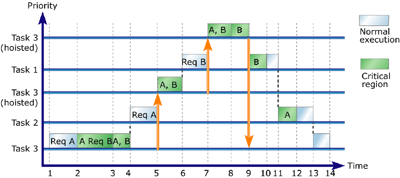
Figure 9: Managing resource ownership (example 2)
- Task 3 is given control of the processor and begins executing. Task 3 requests Resource A.
- Task 3 acquires ownership of Resource A and begins executing its critical region.
- Task 3 requests Resource B.
- Task 3 acquires ownership of Resource B and continues executing its critical region.
- Task 3 is preempted by Task 2, a higher-priority task.
- Task 2 requests ownership of Resource A, which is owned by Task 3.
- Task 3 is hoisted above Task 2 and continues executing its critical region.
- Task 3 is preempted by Task 1, a higher-priority task.
- Task 1 requests Resource B, which is owned by Task 3.
- Task 3 is hoisted above Task 1 and continues executing its critical region.
- Task 3 releases Resource A and continues executing with Resource B.
- Note that Task 3 is not dropped to either its previous
priority or its original priority. To do so would immediately produce a
priority inversion that requires Task 3 to be hoisted above Task 1
because Task 3 still owns Resource B.
- Task 3 releases Resource B and is lowered to its original priority level.
- Task 1 acquires Resource B and continues executing its critical region.
- Task 1 releases Resource B and continues executing normally.
- Task 1 finishes executing and Task 2 acquires Resource A. Task 2 begins executing its critical region.
- Task 2 releases Resource A and continues executing normally.
- Task 2 finishes executing and Task 3 continues executing normally.
- Task 3 finishes executing.
The difficulty of implementing locks that
aren't properly nested becomes apparent when three tasks compete for
two resources, as seen in Figure 9. When Resource A is released at Time
8, low-priority Task 3 remains hoisted to the highest priority. An
improperly designed priority inheritance protocol would lower Task 3 to
its original priority level, which was the task's priority before
acquiring Resource A. Task 3 would then have to be immediately hoisted
above Task 1 to avoid a priority inversion, because of the contention
for access to Resource B. Unbounded priority inversion could occur
while Task 3 is momentarily lowered. A medium-priority task could
preempt Task 3, extending the priority inversion indefinitely.
The example in Figure 8 shows why it's
sometimes desirable to release nested resources "out of order," or not
the reverse of the order in which they were acquired. Although such a
capability is clearly advantageous, many implementations of the
priority inheritance protocol only support sequentially nested resource
locks.
The example in Figure 9 helps show why
it's more difficult to implement priority inheritance while allowing
resources to be released in any order. If a task owns multiple shared
resources and has been hoisted several times, care must be taken when
the task releases those resources. The task's priority must be adjusted
to the appropriate level. Failure to do so may result in unbounded
priority inversion.
Avoid inversion
The best strategy for solving priority inversion is to design the
system so that inversion can't occur. Although priority ceilings and
priority inheritance both prevent unbounded priority inversion, neither
protocol prevents bounded priority inversion. Priority inversion,
whether bounded or not, is inherently a contradiction. You don't want
to have a high-priority task wait for a low-priority task that holds a
shared resource.
Prior to implementing an application,
examine its overall design. If possible, avoid sharing resources
between tasks at all. If no resources are shared, priority inversion is
precluded.
If several tasks do use the same
resource, consider combining them into a single task. The sub-tasks can
access the resource through a state machine in the combined task
without fear of priority inversion. Unless the competing sub-tasks are
fairly simple, however, the state machine might be too complex to
justify.
Another way to prevent priority inversion
is to ensure that all tasks that access a common resource have the same
priority. Although one task might still wait while another task uses
the resource, no priority inversion will occur because both tasks have
the same priority. Of course, this only works if the RTOS provides a
non-preemptive mechanism for gracefully switching between tasks of
equal priority.
If you can't use any of these techniques
to manage shared resources, consider giving a "server task" sole
possession of the resource. The server task can then regulate access to
the resource. When a "client task" needs the resource, it must call
upon the server task to perform the required operations and then wait
for the server to respond. The server task must be at a priority
greater than that of the highest-priority client task that will access
the resource. This method of controlling access to a resource is
similar to the priority ceiling protocol and requires static analysis
to determine the priority of the server task. The method relies on RTOS
message passing and synchronization services instead of resource locks
and dynamic task-priority adjustments.
Prioritize
Priority
inversion is a serious problem that, if allowed to occur, can cause a
system to fail. It's generally simpler to avoid priority inversion than
to solve it in software. If possible, eliminate the need for shared
resources altogether, avoiding any chance of priority inversion. If you
can't avoid priority inversion, at least make sure it's bounded.
Unbounded priority inversions can leave high-priority tasks unable to
execute, resulting in application failure. Two common methods of
bounding priority inversion are the priority ceiling protocol and the
priority inheritance protocol. Neither protocol is perfect for all
situations. Hence, good analysis and design are always necessary to
understand which solution, or combination of solutions, is needed for
your particular application.
W.L. (Bill) Renwick is the founder
and chief engineer of KADAK Products Ltd. He has over 40 years
experience in RTOS design and real-time embedded software. He earned a
BS in electrical engineering from University of Waterloo, Canada, and
an MS in control theory from University of London, UK. Bill can be
reached at amxtech@kadak.com.
Kyle Renwick researched and
authored this article while working at KADAK as a student of Systems
Engineering at University of Waterloo. Kyle can be reached at amxtech@kadak.com.
References
- Jones, Michael. "What really happened on Mars?"Redmond, Washington: Microsoft: 1997. http://research.microsoft.com/~mbj/Mars_Pathfinder/
- Douglass, Bruce Powel. Design Patterns for Real-Time Systems. Boston: Addison-Wesley Professional: 2002.
- Sha, L., R. Rajkumar, and S. Sathaye. "Priority inheritance protocols: An approach to real-time synchronization." IEEE Transactions on Computers, 39 (9), 1175-1185: 1990.